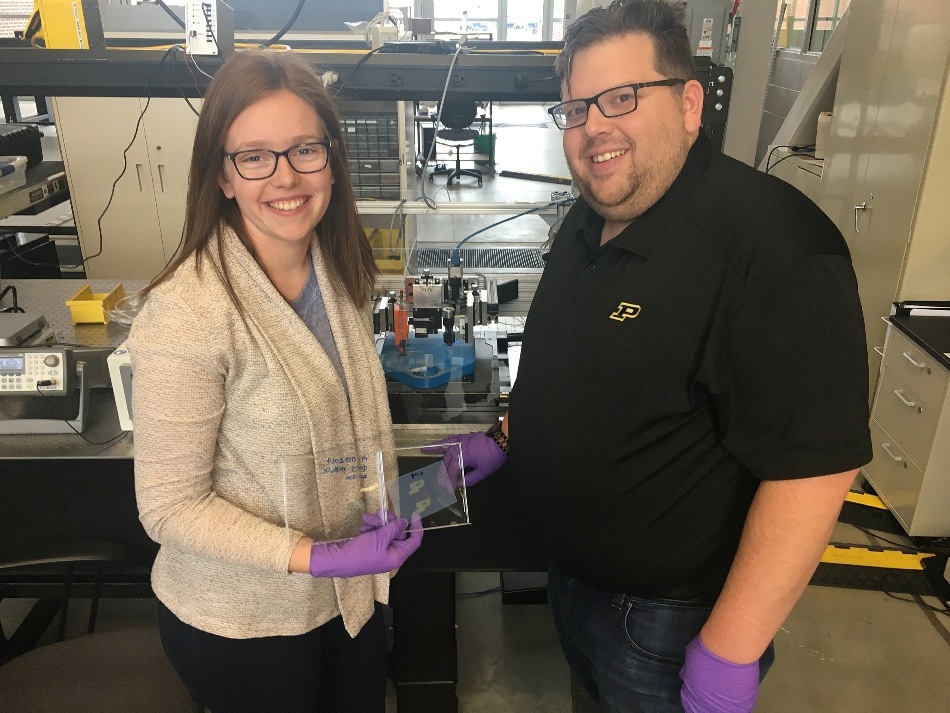Jan 9 2018
Researchers have now developed a method for depositing small amounts of energetic materials (explosives, pyrotechnics and propellants), employing the same technology as an inkjet printer.
 The inkjet-printer was built at Purdue’s Herrick Labs by Allison Murray (left) a doctoral candidate in mechanical engineering, under the direction of professor Jeff Rhoads (right). (Photo credit: Purdue University photo/Jared Pike)
The inkjet-printer was built at Purdue’s Herrick Labs by Allison Murray (left) a doctoral candidate in mechanical engineering, under the direction of professor Jeff Rhoads (right). (Photo credit: Purdue University photo/Jared Pike)
This research, which incorporates Purdue expertise in both additive manufacturing and energetic materials, permits energetic materials to be deposited with unparalleled levels of safety and precision.
“Energetic materials are a fairly understood field, and so is additive manufacturing,” said Allison Murray, a doctoral candidate in Purdue’s School of Mechanical Engineering, who built the custom inkjet printer. “What’s unique about this project is the intersection of those two fields and being able to safely deposit energetic materials with this level of precision.”
A number of micromechanical systems are capable of incorporating energetic materials in their operation. For instance, an automotive airbag deploys employing a minimal amount of solid propellant. However, as devices get smaller, the want for micro-level energetics becomes increasingly critical.
“Our solution is to combine two components as we’re printing them,” said Jeff Rhoads, professor of mechanical engineering, and principal investigator on the project. “We can have a fuel and an oxidizer in two separate suspensions, which are largely inert. Then, with this custom inkjet printer, we can deposit the two in a specific overlapping pattern, combining them on a substrate to form nanothermite.”
“We’re talking about picoliters of material,” Murray said. “It was a challenge to get the right droplet volume and the right pattern.”
The other challenge refers to designing a machine capable of depositing these droplets in an accurate manner. Murray’s machine holds the nozzle stationary and shifts a stage below it to produce whatever shape is needed. “The stage can move with a 0.1 micron precision, which is basically a thousandth the width of a human hair,” she said.
The resulting nanothermite reacts only as powerfully and quickly as thermites applied in standard ways.
“It burns at 2,500 Kelvin [over 4,000 degrees Fahrenheit],” Murray said. “It generates a lot of thrust, a lot of heat, and makes a nice loud shockwave.”
The project, featuring in the Journal of Applied Physics, comprises of a team of 10 researchers and four faculty members from different disciplines in mechanical engineering. Rhoads studies micro-electromechanical systems; George Chiu is a proficient in inkjet printing; and Emre Gunduz and Steve Son work at Zucrow Labs, studying energetic materials like explosives, pyrotechnics, and propellants.
It’s a defining feature of Purdue that professors from such different backgrounds can work together on a project like this. We can combine all of our experiences to collaborate on technologies that weren’t previously realizable.
Jeff Rhoads, Principal Investigator
This research was partially supported by the U.S. Department of Defense, Defense Threat Reduction Agency, via Grant No. HDTRA1-15-1-0010.